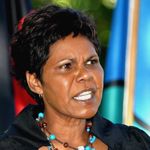
Deadly Vibe Issue 115, September 2006
The Garma Festival – A celebration of culture that brings Aboriginal Australia alive.
The Garma Festival is a vibrant and colourful celebration of the East Arnhem Land Yolngu culture. For five days each year the festival brings a gathering of people to Gulkula – a remote stringybark forest on an escarpment with views out over the Gulf of Carpentaria. Everyone sleeps in tents in the forest and this year there were over 1000 tents pitched among the trees surrounding the festival site.
Gulkula is a site of special significance where the ancestor Ganbulapula brought the yidaki (didjeridoo) into being among the Gumatj people.
The highlight of the festival is the Bunggul – a ceremonial performance of traditional dance and music performed for a couple of hours each afternoon as the sun sets. Local people of every age from the community get involved in the performances.
There was also a traditional dance group, the Yidinji Malluwuy dancers, who travelled all the way from Cairns and Brisbane to perform at Garma. Their performances included the “Shake a Leg” and “Story of a Crocodile”.
There were different events at Garma for everyone.
High school students travelled from all the corners of Arnhem Land so that their bands could perform at the festival each day over the lunch hour. There were bands from Maningrida, Yirrkala, Numbulwar, Angurugu, Gapuwiyak, Groot Eylandt and Elcho Island. The bands practiced out in the bush studio before heading on stage to jam in front of a large audience. The band Djumbung from Milingimbi was chosen to play on the main stage on the last night of the festival in front of hundreds of people.
Year 11 and 12 students from Jabiru High School, in Kakadu, also came to Garma to talk about experiences at their school. Local park ranger Arian Pearson, 24, from Dhimurru Land Management Aboriginal Corporation told the students about the challenges he had faced after coming back from boarding school in Queensland to his home to Yirrkala and re-learning traditional knowledge. Arian’s job now involves saving turtles from ghost nets, patrolling beaches, and helping to move crocodiles out of swimming holes. He encouraged all the students from Jabiru to set goals and follow their dreams.
There were lots of musical performances, especially on the last night of the festival. Yothu Yindi, Casey Donovan, NoKTuRnal and Coloured Stone all performed on the main stage in a huge night of entertainment.
Garma also hosted a youth forum, with over 130 students and children registered to participate. The boys learnt spear-making and went searching for the materials themselves, while the girls tried their hand at honey collecting and made shell bracelets. All the participants had spare time to get involved in the lino prints workshops. The prints were then brought together to be presented as part of the Garma Panel – a huge collaborative art project arranged by Charles Darwin University .
People came from many different parts of the world to take part in the yidaki master class. A group of men (in Yolngu it is tradition that only men play yidaki) came together and were taught by the elders how to find the wood and how to make their own yidaki. They were also given an introduction to the Yolngu language, and were taught special tongue and breathing movements to help them play the ancient and sacred instrument.
The women at the festival came together to learn basket weaving from the elders and to share knowledge in the special women’s healing area. They spent hours scouring the beaches for bush materials to use in the healing ceremonies and they all came together to learn traditional dance from the Yolngu women.
The Garma site is in a remote area, far away from city lights, so the night sky is lit up brightly by stars. The Gove Astronomical Society came to the festival to teach people about the different constellations. They set up five telescopes so people could observe the moon, the stars and the planets in closer detail. The full moon on the final night of Garma was so bright it blocked out some of the stars and the entire Milky Way.
The Art Gallery at Garma was set in an enchanting magical forest. All the trees in one area were painted white and contemporary, bright-coloured prints hung from the tree trunks with lights shining down individually on each piece of artwork. It was a beautiful natural setting for an art gallery.
Garma celebrates all Indigenous cultures, and there were some special guests at the festival this year. There were many Maori from New Zealand and they performed their traditional men’s dance, the haka, on the final Bunggul at the festival. There was also a native American, Littlehawk, who plays a traditional American Indian flute. Littlehawk had a jamming session with actor Jack Thompson on the harmonica and Casey Donovan singing, all accompanied by a musician playing background music on yidaki.
Garma is a wonderful and essential event. The festival buzzes with constant activity, and is filled with interesting people of all backgrounds. It is a celebration of Indigenous cultures and, most importantly, a means of educating the country and the world about the world’s oldest race – Aboriginal Australia.

Comments are closed.